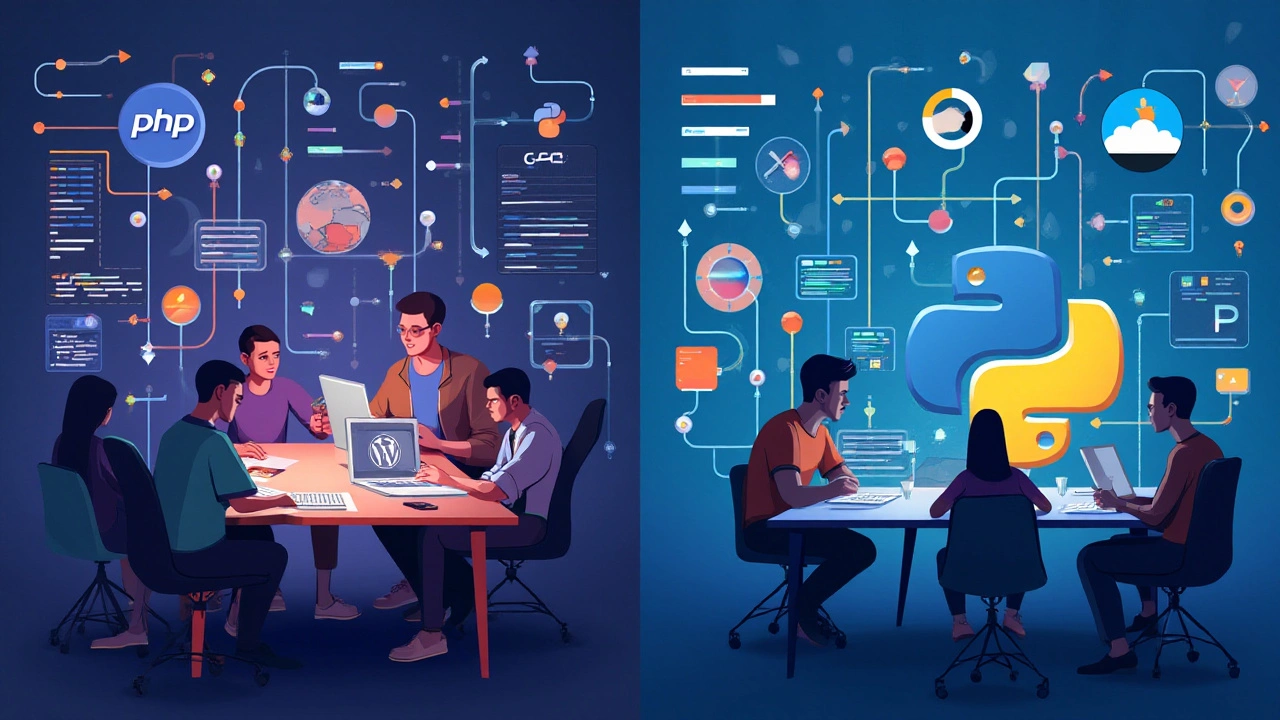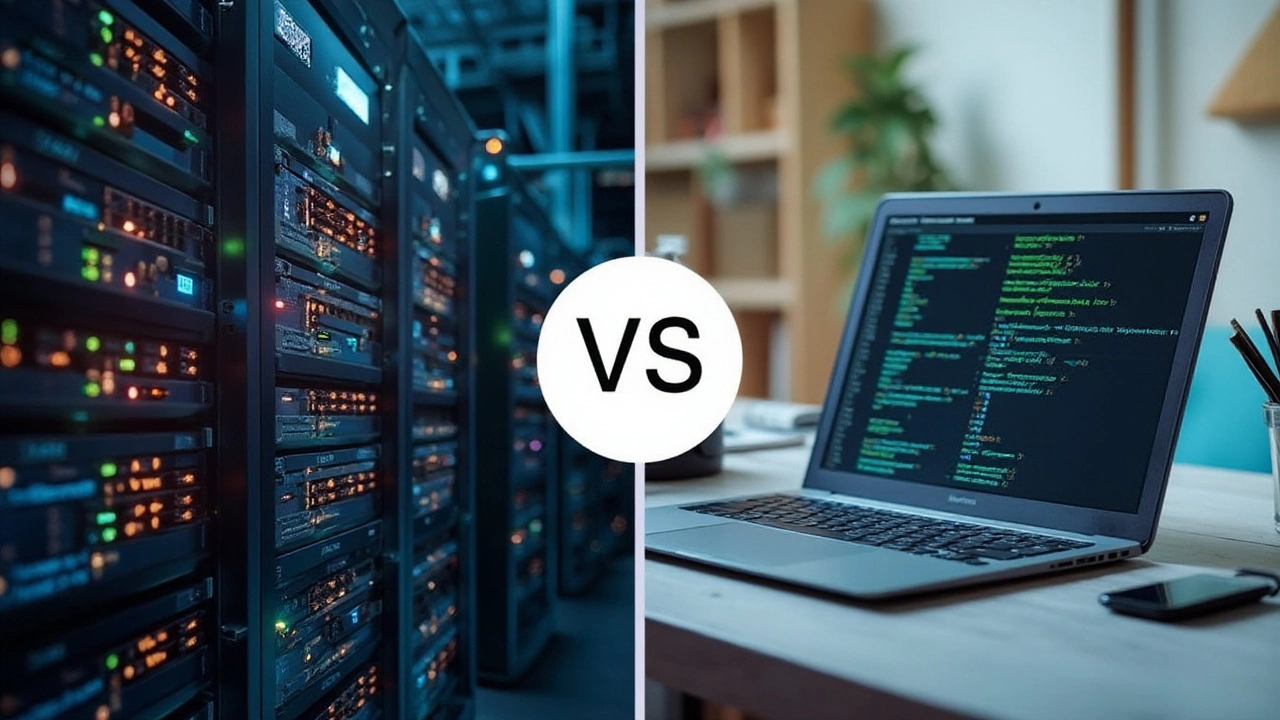In the world of coding, PHP and Python stand out not only as popular choices but also as powerful tools with distinctive capabilities. Choosing between these two often boils down to what you're aiming to achieve in your project.
PHP started its journey as a robust server-side scripting language, fueling websites like WordPress with its specialized efficiency. On the flip side, Python's rise in popularity is attributed to its general-purpose nature and readability, making it a favorite among beginners and experts alike.
This discussion dives into the intricacies of PHP and Python, exploring their performance, usability, and which circumstances might make one shine over the other. Let's delve into the dynamics of these languages that continue to shape the digital landscape.
- Understanding PHP and Python
- Performance and Usability
- Use Cases and Flexibility
- Community and Ecosystem
Understanding PHP and Python
In the realm of programming languages, understanding what sets PHP and Python apart is fundamental. PHP, which stands for Hypertext Preprocessor, was introduced way back in 1995. It was conceived as a tool for quick and effective scripting, focusing primarily on server-side development. This initiative led to PHP's adoption in content-heavy web environments, notably WordPress, Drupal, and Joomla. Over time, these platforms redefined the digital space by providing robust content management solutions. PHP's syntax is reminiscent of older languages like C, which lends it a certain degree of versatility but can also appear cryptic to new developers.
On the other hand, Python, created by Guido van Rossum and first released in 1991, has carved its niche in a plethora of domains. Unlike PHP, Python was not designed with a single purpose in mind. Instead, it boasts a clean, intuitive syntax, which makes it a preferred choice for beginners and seasoned coders alike. The Python community often refers to its philosophy—'There should be one—and preferably only one—obvious way to do it.' This mantra celebrates clarity and simplicity over complexity. Python's use extends beyond web development; it's a favorite in data science, artificial intelligence, and automation, showcasing its flexible nature.
"Python has become the language of choice for data analysis in various disciplines, underscoring its versatility." — Eric Raymond, Open Source Advocate
From a technical standpoint, PHP scripts are usually executed on a server. This means that a user's browser only receives the final generated HTML, while complex computations occur behind the scenes. This property enhances security by concealing the underlying code. Python, by contrast, can be implemented in many ways, thanks to frameworks such as Django and Flask that support web application development. Such frameworks enable rapid prototyping, which is an integral part of tech innovation today.
While both languages provide ample opportunities for coders, making the right choice hinges on specific project needs. For instance, if the goal is to develop a website with dynamic content and database interaction, PHP might have a slight edge. Conversely, if a project leans towards complex data manipulation or machine learning, Python could prove to be more beneficial. Ultimately, the lines between these applications are blurring, encouraging developers to adopt multi-language proficiency for their tech toolkit.

Performance and Usability
When measuring the performance of programming languages like PHP and Python, the debate often centers on speed, memory usage, and scalability. PHP was originally crafted for server-side scripting, making it highly specialized in delivering web pages faster than many other languages. Its core strength lies in handling HTTP requests, which makes it exceptionally efficient for websites with heavy traffic, like e-commerce platforms.
On technical tests, PHP has shown remarkable native performance when it comes to executing compiled bytecode, mainly due to the Zend Engine, which implements meticulous performance tuning. Don't forget that PHP includes built-in features for connecting with MySQL databases, streamlining processes that involve web-based data management. This close integration drastically improves performance, since database calls are a significant bottleneck in web applications.
“PHP is about as fast as 'C' for dynamic page generation,” states evolving software engineer and advocate Rasmus Lerdorf, highlighting this fluidity.
In comparison, Python is not traditionally the go-to for raw execution speed. However, it makes up for this in different ways. Thanks to its readability and extensive libraries, Python excels in usability. With an intuitive syntax that mirrors human language closely, Python reduces the learning curve drastically. This simplicity allows developers to write and maintain scripts faster, which, in turn, can reduce development time and costs. Python's third-party libraries, like NumPy for numerical data processing, are a treasure trove for developers. Python's flexibility also means it can easily handle tasks outside simple web app development, such as machine learning and data analysis, offering an edge in projects requiring advanced computational power.
When considering real-world systems, one must evaluate not just base performance, but also how the languages handle usability and developer productivity, both of which are crucial in longer project cycles. Developers often find Python's ease-of-use a game-changer for prototyping and deploying scalable applications with refined coding efficiency. Its extensive support for various data types, structures, and interoperability frameworks stays unparalleled.
Usability in the context of project scalability comes down to runtime environments and how each language accommodates growth. PHP's ecosystem, rich with Content Management Systems (CMS) like WordPress, offers instant scalability. In contrast, Python's versatility plays heavily in its favor, as it seamlessly stretches its capabilities into building more complex applications and extending microservices architectures without incurring significant overheads.
Comparative Analysis
To bolster your decisions, reflecting on the differences becomes essential. A helpful comparison of specific scenarios unveils both languages' strength. For instance, if speed-efficient, server-heavy workloads dominate your requirements, PHP might appear a wise choice due to its precise call-tuning functions. Conversely, when the emphasis is on swift development cycles or incorporating vast data analytics, Python's toolkit promotes rapid integration and testing phases with its comprehensive libraries. Remembering such practical insights assists in aligning technology decisions closer with project goals.

Use Cases and Flexibility
Exploring the uses and adaptability of PHP and Python unveils a rich tapestry of scenarios where each language excels. PHP has long been a cornerstone in the world of web development. Its prowess lies in creating dynamic web pages, and it's particularly favored for building Content Management Systems (CMS) like WordPress, Drupal, and Joomla. Its server-side scripting capabilities are unmatched when it comes to developing web-based applications where direct interaction with databases and server management is a requisite. E-commerce platforms like WooCommerce and Magento thrive on PHP, ensuring that the language maintains its relevance in the digital marketplace.
On the other hand, Python is revered for its versatility and the breadth of its deployability. From web applications running on frameworks like Django and Flask to automating repetitive tasks with scripts, Python proves its mettle in myriad domains. Its readability and simplistic syntax lower the barrier to entry, allowing novices to pick up the language swiftly. Python stands out in the fields of Artificial Intelligence (AI) and machine learning, with libraries like TensorFlow and PyTorch being integral to innovation and development. Its use extends into data science, where Python's numerics and data handling capabilities ensure a broad application range in fields such as finance and biostatistics.
Flexibility is another area where these languages distinguish themselves. PHP's syntax and tools have been refined to handle web-oriented tasks efficiently, enabling developers to create scalable and secure applications tailored specifically for online interaction. Meanwhile, Python's flexibility shines through its cross-platform compatibility and extensibility with libraries like SciPy, Pandas, and NumPy broadening its scope dramatically. "Python is remarkable not just because of its ability to easily automate tasks, but also due to its adaptability to future needs and technologies," notes Guido van Rossum, the creator of Python.
When aligning a language with project needs, considering the community and ecosystem associated with PHP and Python can provide valuable insight. PHP developers benefit from a long-established community and a robust assortment of open-source tools and frameworks specifically tailored for web development. PHP's ease of deployment in web hosts, coupled with its native support for HTTP, makes it a go-to choice for developers focused on web-related projects. Conversely, Python enjoys an enthusiastic, continually-growing community thanks to its general-purpose appeal and wide range of applications, providing a nurturing environment full of shared knowledge and support. The Python Package Index (PyPI) hosts a vast array of libraries that address almost any need, reflecting just how adaptive and resourceful the Python ecosystem truly is.

Community and Ecosystem
The fertile ground of community and ecosystem is where programming languages truly blossom. Both Python and PHP have thrived here, albeit with distinct pathways and characteristics. When we talk about community, we're talking about the people—the coders, the tinkerers, the developers—who contribute to the growth of the language. PHP has been around for decades, beginning in the mid-1990s, and it has a large, dedicated base of developers. This loyalty is in part due to how well-accepted PHP has become in industries reliant on web development. This expansiveness means PHP developers can tap into massive resources—forums, tutorials, and open-source projects—nourished by a vast global network.
On the flip side, Python has accelerated into many domains thanks to its open source and apparently beginner-friendly design. The Python community is known for its welcoming nature, inclusive just like the code itself. It draws in developers from fields wide and varied, from web development to data science, machine learning, and beyond. This eclectic user base feeds Python projects with a diversity of ideas and solutions. The scrappiness of the community is evidenced by the countless number of specialized frameworks and libraries. Django and Flask, for web applications, and Pandas and NumPy, for data manipulation, are but a few of the powerhouse tools born out of this ecosystem.
"The easiest way to learn Python is to immerse yourself in the community," claims a renowned Python developer at PyCon.This kind of widespread support is something to admire and emulate.
Beyond the individual programmers, the sheer number of conferences hosted around the globe for both languages reflects their vibrancy. PHP's historical backbone as the go-to language for WordPress means it has consistently been at the core of web hosting conversations. By contrast, Python is celebrated at gatherings that cover a scope far beyond web development. PyCon is a perfect example where Python's versatility is put shamelessly on full display. The variety of contexts allows Python enthusiasts to come together, share strategies, and forge new paths. In terms of published resources, both PHP and Python boast an extensive collection of books, online courses, and certification programs that further empowers their user communities.
Let us not overlook the contribution management systems themselves. PHP enjoys stalwarts like Composer, a dependency manager that eases package management tasks, as well as the influential Packagist, a repository of PHP packages. In the Python domain, the pip system is renowned and universally used for installing and managing Python libraries. Such tools facilitate seamless integration, which cannot be understated as they save programmers considerable time and effort when executing complex codes. As a study reveals, automation and efficiency achieved through these tools contribute to over a 50% reduction in development time on average.
Finally, both ecosystems foster open-source culture, with projects readily available for public modification. This democratization of programming facilitates innovation and problem-solving across diverse fields, regardless of geographic and economic boundaries. With this collaborative spirit, the ecosystems have continued to expand, ensuring both PHP and Python remain cornerstones of technology-driven problem-solving. Each community is a testament to the language’s strengths, continuously nurturing methodologies and expanding functionalities. Indeed, a developer's choice will often depend on where they feel more aligned, whether that's in PHP’s web-specific prowess or Python's broad-spectrum accessibility.
